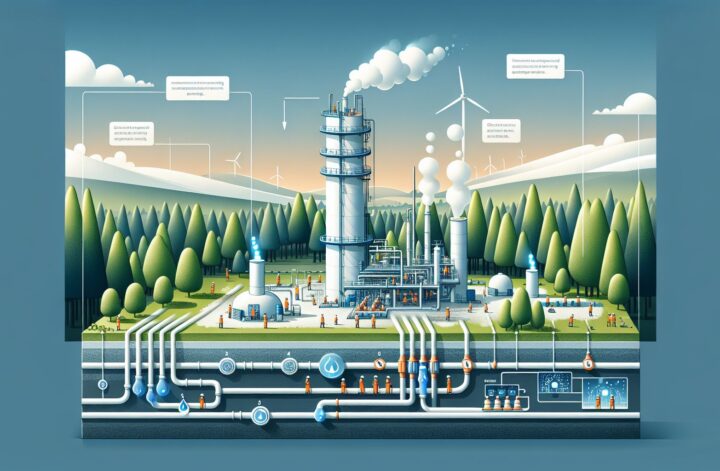Renewable energy has become an increasingly significant topic of discussion amid climate change fears. Central to this dialogue is the subject of biogas production — an eco-friendly alternative to traditional fossil fuels. Today, we will be delving into the intricacies of biogas production, its relevance in organic waste treatment, and the impact on the renewable energy sector.
What is Biogas?
Biogas is a type of biofuel that is naturally produced from the decomposition of organic waste. It is primarily composed of methane (CH4) and carbon dioxide (CO2), presenting a renewable energy source that reduces greenhouse emissions when used in place of fossil fuels[^1^].
Biogas Production: How It Works
The production of biogas occurs in a process known as anaerobic digestion, which takes place in an anaerobic digester or a bioreactor. Four key stages are involved in this process: hydrolysis, acidogenesis, acetogenesis, and methanogenesis[^2^].
-
Hydrolysis: In the first stage, complex organic matter is broken down into simple sugar monomers, facilitated by hydrolytic bacteria.
-
Acidogenesis: The simple molecules are further converted into long chain fatty acids by acidogenic bacteria.
-
Acetogenesis: These long chain fatty acids are then converted into acetic acid, CO2, and hydrogen.
-
Methanogenesis: This final step involves the conversion of these products into methane, CO2, and water by methanogenic archaea[^3^].
Biogas and Organic Waste Treatment
Biogas production offers a dual solution for environmental sustainability by managing organic waste and producing renewable energy. The organic waste used in biogas production can include manure, crop residues, food waste, and even sewage sludge. The process of organic waste treatment for biogas production not only reduces the volume of waste being sent to landfills, but it also contributes to a significant reduction in greenhouse gas emissions[^4^].
Organic Loading Rate and Biogas Yield
Organic Loading Rate (OLR) is an essential parameter in the anaerobic digestion process and has a direct influence on the quantity of biogas produced. It measures the quantity of organic material that is fed into the digester per unit volume per day. Consequently, optimizing the OLR is crucial for efficient biogas production[^5^].
Inhibitors of Anaerobic Digestion
While anaerobic digestion is a robust and dependable process, certain factors can inhibit its effectiveness. Two common inhibitory factors are ammonia toxicity and sulfide toxicity. High levels of ammonia can potentially harm the anaerobic digestion process, impairing the overall biogas yield. Meanwhile, Hydrogen sulfide (H2S), which is often found in biogas, is corrosive and can cause damage to the equipment used in biogas production[^6^].
The Future of Biogas Production and Renewable Energy
Amid escalating environmental concerns, the future points towards a gradual transition from fossil fuels to renewable energy sources. While solar and wind energy have gained substantial attention, the potential of biogas as a reliable and potent renewable energy source can’t be overlooked. As a carbon-neutral fuel, biogas could play a pivotal role in combating climate change and securing energy future.
That’s biogas production in a nutshell. Intricate, fascinating, and beneficial on multiple levels, it offers a promising avenue towards a future where energy production does not compromise our love for Mother Earth.
Sources
[^1^]: Agler MT, Wrenn BA, Zinder SH, Angenent LT. Waste to bioproduct conversion with undefined mixed cultures: the carboxylate platform. Trends in Biotechnology. 2011;29(2):70-78. doi:10.1016/j.tibtech.2010.11.006
[^2^]: Deublein D, Steinhauser A. Biogas from waste and renewable resources: an introduction. Wiley-VCH. 2008. ISBN 978-3-527-31841-4.
[^3^]: Mosey FE. Mathematical modelling of the anaerobic digestion process: regulatory mechanisms for the formation of short-chain volatile acids from glucose. Water Science and Technology. 1983;15(8-9):209-232
[^4^]: Hjorth M, Gränitz K, Adamsen APS, Møller HB. Extrusion as a pretreatment to increase biogas production. Bioresource Technology. 2011; 102(8):4989-4994.
[^5^]: Zahedi S, Solera R, Molerob J, Pérez J. The influence of the organic loading rate on the performance of a UASB reactor treating paper industry wastewater. Chemical Engineering Journal. 2010; 165(2):458-465.
[^6^]: Calli B, Mertoglu B, Inanc B, Yenigun O. Community changes during start-up in methanogenic bioreactors exposed to increasing levels of ammonia. Environmental Technology. 2005; 26(1):85-91.




